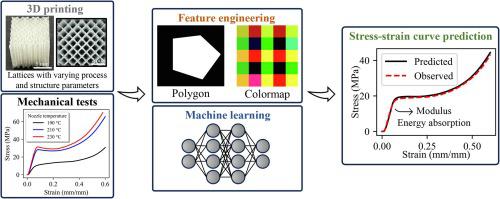当前位置:
X-MOL 学术
›
Mater. Des.
›
论文详情
Our official English website, www.x-mol.net, welcomes your feedback! (Note: you will need to create a separate account there.)
Machine learning and feature representation approaches to predict stress-strain curves of additively manufactured metamaterials with varying structure and process parameters
Materials & Design ( IF 8.4 ) Pub Date : 2024-04-10 , DOI: 10.1016/j.matdes.2024.112932 Qingyang Liu , Dazhong Wu
Materials & Design ( IF 8.4 ) Pub Date : 2024-04-10 , DOI: 10.1016/j.matdes.2024.112932 Qingyang Liu , Dazhong Wu

|
Lattice structures, one type of mechanical metamaterials, exhibit excellent mechanical properties such as a high strength-to-weight ratio and energy absorption capacity. However, predicting the stress–strain relationship of lattice structures remains a challenge because the mechanical behaviors of additively manufactured lattices are affected by both the structure parameters of a lattice and process conditions. This study proposes a machine learning (ML)-based predictive modeling framework to predict the entire stress–strain curves, compressive modulus, and energy absorption of lattice structures with varying structure and process parameters. Feature engineering techniques are used to transform raw data into new data representations compatible with ML models, including artificial neural networks, long short-term memory (LSTM), and convolutional neural networks (CNN). Two novel feature representations, including polygons and colormaps, are developed to transform structure and process parameters from tabular format into image format for CNN. The LSTM model that predicts stress–strain curves achieves a minimum mean absolute percentage error (MAPE) of 0.147. The CNN (colormap) model achieves a minimum MAPE of 0.174 when predicting compressive modulus. The ANN and LSTM models achieve a minimum MAPE of 0.068 when predicting energy absorption. The training time to build these ML models is less than 6 min.
中文翻译:

机器学习和特征表示方法可预测具有不同结构和工艺参数的增材制造超材料的应力应变曲线
晶格结构是一种机械超材料,具有优异的机械性能,例如高强度重量比和能量吸收能力。然而,预测晶格结构的应力-应变关系仍然是一个挑战,因为增材制造晶格的机械行为受到晶格结构参数和工艺条件的影响。本研究提出了一种基于机器学习(ML)的预测建模框架,用于预测具有不同结构和工艺参数的晶格结构的整个应力-应变曲线、压缩模量和能量吸收。特征工程技术用于将原始数据转换为与 ML 模型兼容的新数据表示,包括人工神经网络、长短期记忆 (LSTM) 和卷积神经网络 (CNN)。开发了两种新颖的特征表示(包括多边形和颜色图),用于将结构和过程参数从表格格式转换为 CNN 的图像格式。预测应力应变曲线的 LSTM 模型实现了 0.147 的最小平均绝对百分比误差 (MAPE)。 CNN(颜色图)模型在预测压缩模量时实现了 0.174 的最小 MAPE。 ANN 和 LSTM 模型在预测能量吸收时的最小 MAPE 为 0.068。构建这些 ML 模型的训练时间不到 6 分钟。
更新日期:2024-04-10
中文翻译:

机器学习和特征表示方法可预测具有不同结构和工艺参数的增材制造超材料的应力应变曲线
晶格结构是一种机械超材料,具有优异的机械性能,例如高强度重量比和能量吸收能力。然而,预测晶格结构的应力-应变关系仍然是一个挑战,因为增材制造晶格的机械行为受到晶格结构参数和工艺条件的影响。本研究提出了一种基于机器学习(ML)的预测建模框架,用于预测具有不同结构和工艺参数的晶格结构的整个应力-应变曲线、压缩模量和能量吸收。特征工程技术用于将原始数据转换为与 ML 模型兼容的新数据表示,包括人工神经网络、长短期记忆 (LSTM) 和卷积神经网络 (CNN)。开发了两种新颖的特征表示(包括多边形和颜色图),用于将结构和过程参数从表格格式转换为 CNN 的图像格式。预测应力应变曲线的 LSTM 模型实现了 0.147 的最小平均绝对百分比误差 (MAPE)。 CNN(颜色图)模型在预测压缩模量时实现了 0.174 的最小 MAPE。 ANN 和 LSTM 模型在预测能量吸收时的最小 MAPE 为 0.068。构建这些 ML 模型的训练时间不到 6 分钟。



























 京公网安备 11010802027423号
京公网安备 11010802027423号